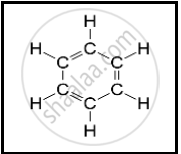Advertisements
Advertisements
प्रश्न
What is graphite?
उत्तर
Graphite is an allotrope of carbon, and is a soft, greyish black and opaque substance. The graphite is made up of carbon atoms
APPEARS IN
संबंधित प्रश्न
What are covalent compounds?
An element L consists of molecules.
What type of bonding is present in the particles that make up L?
What type of bonds are present in H2 molecule? Draw their electron-dot structures.
Give one example of a molecule containing a single covalent bond.
Fill in the blank in the following sentence:
Two atoms of the same element combine to form a molecule. The bond between them is known as ................ bond.
Fill in the blank in the following sentence:
The number of single covalent bonds in C2H2 molecule are ...........
Explain the formation of a chlorine molecule on the basis of electronic theory of valency.
What is diamond? Of what substance is diamond made?
An element A has 4 valence electrons in its atom whereas element B has only one valence electron in its atom. The compound formed by A and B does not conduct electricity. What is the nature of chemical bond in the compound formed? Give its electron-dot structure.
Give the characteristic properties of covalent compounds.
Draw an electron dot structure of the following molecule. (Without showing the circle) :
Ethene
The following structural formula belongs to which carbon compound?

Explain the following briefly.
Pure water does not conduct electricity, but on adding sodium chloride to it, it starts conducting electricity.
Explain the structure of Ammonium ion.
(a) Compound X consists of molecules.
Choose the letter corresponding to the correct answer from the choices (a), (b), (c) and (d) given below
X is likely to have a :
Explain why carbon tetrachloride does not dissolve in water.
What is the difference between :
Ionic compounds and covalent compounds
Complete the following activity.
Write the names of the hydrocarbons for the following structural formula.
(isobutylene, cyclohexane, propene, cyclohexene, cyclopentane, benzene, propyne, isobutane, propane)
| \[\begin{array}{cc}\phantom{......}\ce{H}\phantom{...}\ce{H}\phantom{...}\ce{H}\phantom{..}\\ \phantom{.....}|\phantom{....}|\phantom{....}|\\ \ce{H - C - C = C}\\\phantom{.....}|\phantom{.........}|\\ \phantom{.....}\ce{H}\phantom{........}\ce{H}\end{array}\] |
Complete the following activity.
Write the names of the hydrocarbons for the following structural formula.
(isobutylene, cyclohexane, propene, cyclohexene, cyclopentane, benzene, propyne, isobutane, propane)
| \[\begin{array}{cc} \phantom{..}\ce{H}\phantom{...}\ce{H}\phantom{...}\ce{H}\\ \phantom{..}|\phantom{....}|\phantom{....}|\\ \ce{H - C - C- C- H}\\ \phantom{.}|\phantom{....}|\phantom{....}|\\ \ce{H - C - H}\\ |\\\ce{H}\end{array}\] |
The bond which is formed by the mutual sharing of electrons is called ______ bond.
